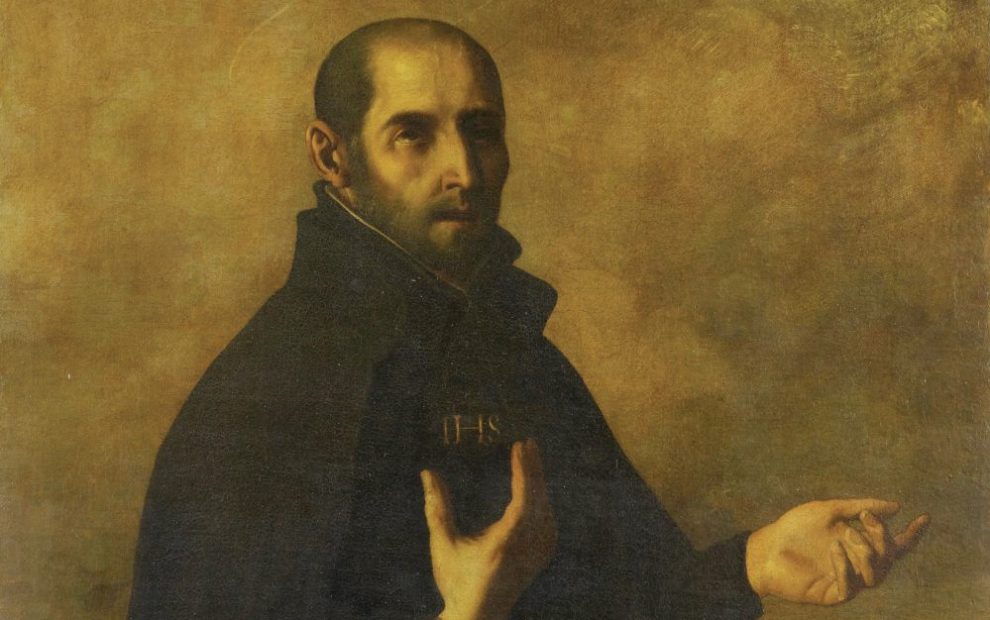I first encountered St. Ignatius of Loyola when I was a boy. My grandmother had volunteered with Father Pedro Arrupe (one of the great Ignatian social activists), and although she was a Baptist, Arrupe’s spirituality deeply impressed her. As she talked with me about the Ignatian practice of seeing God in everything, I became curious about this 16th-century saint. I wanted to get to know him better.
To my surprise, I learned that St. Ignatius had not started out as a particularly holy person. He was not one of those saints who saw visions or performed miracles from the time he was a young child. Instead, St. Ignatius grew up daydreaming about adventure and romance. While he was still a teenager, he became a soldier. He was too busy drinking, brawling, gambling, and flirting to have much time for God.
Then one day in 1521 something happened that changed him forever. In the midst of battle, a cannonball wounded both of his legs. Afterward, he underwent a long and painful convalescence.
This incident, known as St. Ignatius’ “cannonball experience,” has become a metaphor for life’s unexpected catastrophes—those events that force us to come to a standstill, reconsider our lives, and then change direction. Over the past couple of years, our world has had a number of these experiences. From the COVID-19 pandemic to the murder of George Floyd, from natural disasters to the bad news about the inevitability of climate change, we, like St. Ignatius, have been knocked off our feet and had our old lives shattered.
I too have had my share of personal “cannonballs.” Lately, it seems as though I face a constant barrage of them. The more I speak out against racism, the more I become the target of those who feel threatened by my message. Like St. Ignatius’ cannonball, these racist assaults are fueled by our world’s hatred, violence, and division. Sometimes, they strike as blatant microaggressions from colleagues; other times, they come as threats on my life. Either way, like all weapons of destruction, they have the power to wound, even kill.
But I have learned an important lesson from St. Ignatius: I can choose how I respond to these assaults. St. Ignatius might have allowed his injury to fill him with anger and bitterness. He could have chosen to continue his life of violence and self-indulgence, bringing hurt to others just as he had been hurt. Instead, he allowed his pain to transform him into someone new. He turned away from human hatred and was remade into a vehicle of divine love.
This did not happen automatically or easily, however. Although 1521 is celebrated as the year of his conversion, St. Ignatius did not instantly rise to a life of sainthood. Instead, his quick temper and propensity for violence lingered with him, as we can see from a story he tells in his autobiography.
God can do amazing things when we surrender our lives to the power of love.
Advertisement
A year after his conversion, as he was riding a mule on his way to Montserrat, Spain, he encountered a Moor—a man with black skin—and the two men fell into a discussion about the Virgin Mary. The Moor believed Mary was a virgin when she conceived Jesus, but he had difficulty accepting that she remained a virgin after her marriage to Joseph. St. Ignatius vehemently disagreed. When St. Ignatius parted from the man, his anger was so great he was tempted to turn around, chase down the Black man, and kill him. He had himself more than half-convinced that this act of violence would actually be the will of God.
Luckily, he had just enough sense to question this course of action, and so he decided to leave the decision up to his mule. When he reached a fork in the road, one road leading in the direction the Black man had taken and the other going the opposite way, St. Ignatius dropped the reins and let the mule choose its path. If the mule followed the Black man, St. Ignatius made up his mind to murder him—but if the mule took the opposite path, he would go on his way.
The mule took the opposite path, and the Moor’s life was spared. St. Ignatius went on to Montserrat, where, in an all-night vigil before the Black Madonna, he hung up his sword and dagger. With these actions, he demonstrated that he was separating himself from the rage and violence that had ruled his life. Now, he allowed Christ to replace his hatred and selfishness with an unconditional love for all humanity.
St. Ignatius knew what the reader would see in this story: a man still ruled by his temper, a man ready to kill to defend his ideas. This earlier version of himself did not perceive the image of God in the Black man. If not for the mule, the Moor might have lost his life in the name of religion. St. Ignatius writes that his goal in including stories like these in his autobiography was “in order that it may be seen how God was dealing with his soul.”
Later, after his stay in Montserrat, St. Ignatius went on to Manresa, Spain, where, as he sat beside the river outside town, “the eyes of his understanding began to be opened.” God was continuing the work of divine transformation in his life. “He understood and learned many things,” he writes, “with so great an enlightenment that everything seemed new to him.”
Value above everything the great service which is given to God because of pure love.St. Ignatius of Loyola
Each time I meditate on this story, I examine my own heart. Even as I encounter the cannonballs of injustice and racism, I am challenged to make unconditional love my standard. In response to this challenge, I seek to allow God to transform the hatred and violence I encounter daily into the possibility of life and hope. God can do amazing things when we surrender our lives to the power of love.
In the months and years after his conversion, St. Ignatius’ entire life changed. He realized his thoughts and feelings had been “disordered”—in other words, out of balance, unhealthy, pulling him away from his true God-given identity. Eventually, he would accomplish many things: create a new religious order, the Society of Jesus (the Jesuits); start schools; build hospitals; establish rehabilitation homes for prostitutes; become the confessor and counselor for popes, kings, and queens; nurture parishes; and more. In the midst of his busy life, however, he kept his focus on the divine love that motivated all he did.
When St. Ignatius wrote The Spiritual Exercises, a powerful guidebook for every person on a spiritual journey, he gave us all a road map for following in his footsteps. The very last paragraph calls each of us to “value above everything else the great service which is given to God because of pure love.” Today, despite the vicious cannonballs of racism, I open myself to a love that embraces all, that refuses to accept that anyone should be marginalized or forgotten. I use my written words, my teaching, my speaking, and everything I do for Christ’s cause—the cause of justice, healing, and love.
As St. Ignatius knew full well, God speaks to each of us individually. God uses even our wounds to transform us into something new, something wonderful that God is calling into being. Ask the Holy Spirit to show you a new path toward healing, toward action, toward love. As St. Ignatius would tell you, “We cannot expect too much from God.”
This article also appears in the January 2022 issue of U.S. Catholic (Vol. 87, No. 1, pages 45-46). Click here to subscribe to the magazine.
Image: Wikimedia Commons/Francisco de Zurbaran, 17th century.













Add comment